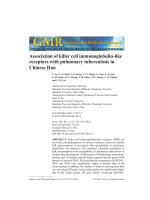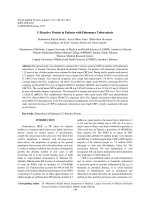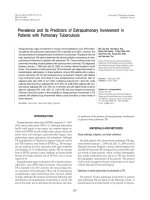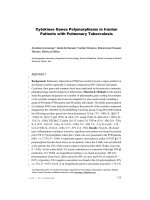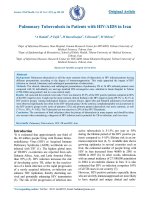C-Reactive Protein in Patients with Pulmonary Tuberculosis ppt
Bạn đang xem bản rút gọn của tài liệu. Xem và tải ngay bản đầy đủ của tài liệu tại đây (34.6 KB, 5 trang )
World Applied Sciences Journal 17 (2): 140-144, 2012
ISSN 1818-4952
© IDOSI Publications, 2012
Corresponding Author: Dr. Muhammed Khalid Shaikh, Department of Medicine, Liaquat University of Medical and Health
Sciences Jamshoro / Hyderabad (LUMHS), Sindh, Pakistan.
140
C-Reactive Protein in Patients with Pulmonary Tuberculosis
Muhammed Khalid Shaikh, Javed Akhtar Samo, Bikha Ram Devrajani,
1 2 3
Syed Zulfiquar Ali Shah, Samina Shaikh and Imran Shaikh
1 1 1
Department of Medicine, Liaquat University of Medical and Health Sciences (LUMHS), Jamshoro, Pakistan
1
Ghulam Muhammad Mahar Medical College (GMMMC) Sukkur, Sindh, Pakistan
2
Director, Medical Research Center,
3
Liaquat University of Medical and Health Sciences (LUMHS), Jamshoro, Pakistan
Abstract: The present study was conducted to evaluate the C-reactive protein (CRP) in patients with pulmonary
tuberculosis at Liaquat University Hospital, Hyderabad, Pakistan. All patients with pulmonary tuberculosis
> 12 years of age, of either gender were evaluated for their serum CRP level. During twelve months study period,
127 patients with pulmonary tuberculosis were evaluated for CRP level, of which 76 (60%) were males and
51 (40%) were females. The observed symptoms were cough and expectoration 115 (91%), weakness and
constant fatigue 92(72%), weight loss 110 (86%), fever 90(71%), night sweats 85(67%), chest pain 95(75%),
coughing up blood 98(77%), loss of appetite 88(69%), headache 102(80%) and combined / mixed symptoms
100(79%). The overall mean CRP in patients with TB was 9.87±4.83 where as it was 11.21±3.32 and 13.82±4.63
in male and female subjects respectively. The mean±SD of normal and raised serum CRP was 2.76±1.34 and
13.26±4.42 (p#0.01). The complications observed in patients with raised serum CRP were pneumothorax
04(4.7%), fibrosis 08(9.3%), miliary TB 06(7%), empyema 10(11.6%), fungal colonization within tuberculous
cavity 09(10.5%), bronchiectasis 11(12.8%), more than 01 complication 11(12.8%) and Nil 19(22.1%). The present
study detected elevation of CRP in pulmonary tuberculosis and a high CRP is clearly associated with more
severe disease.
Key words: Tuberculosis % Pulmonary % C-Reactive Protein
INTRODUCTION million are smear positive; the annual risk of infection is 1
Tuberculosis, MTB, or TB (short for tubercle major cause of illness and death worldwide especially in
bacillus) is a common and in many cases lethal, infectious Africa and Asia, in Nigeria, a prevalence of 460,000 has
disease caused by various strains of mycobacteria, been reported [5]. The WHO in its report of 2007
usually Mycobacterium tuberculosis [1]. One third of the estimated that globally 8.8 million people were infected
world’s population is infected with Mycobacterium with TB and 1.6 million people died of TB in 2005 and the
tuberculosis; the proportion of people in the general majority of the infected people i.e. 7.4 million (84%)
population who become sick with tuberculosis each year belonged to Asia and Sub-Saharan Africa [6]. The
is stable or falling worldwide but, because of population association between TB and malnutrition is well
growth, the absolute number of new cases is still recognized; TB can lead to malnutrition and malnutrition
increasing [2]. It is the second leading cause of adult may predispose to tuberculosis [7].
death in impoverished communities of Pakistan [3]. CRP is an established marker of acute inflammation
Globally, Pakistan ranks 8th in terms of estimated number and its serum concentration is frequently determined
of cases by WHO, with an incidence of 175/100,000 to assess the grade of systemic inflammation [8], e.g., in
persons [3]. Pakistan alone accounts for 44% of total TB rheumatic or intestinal diseases, or to verify bacterial
burden in the Eastern Mediterranean Region of the WHO etiology of inflammation such as pneumonia and
comprising 23 countries [3]. In India, approximately 4.8 tuberculosis in adults. Recently, the immunoturbidimetric
million people are suffering from TB infection of which 2.2 method on latex particles has been used to determine very
to 2% and the case fatality rate is 24% [4]. It is also a
World Appl. Sci. J., 17 (2): 140-144, 2012
141
low CRP concentrations thus enabling the use of CRP mean and standard deviation (SD) was calculated for age
concentration as a prognostic marker of chronic and CRP. The stratification was done for age, gender,
inflammation in patients with cardiovascular disease, C-reactive protein (CRP) in patients with pulmonary
diabetes mellitus [9, 10], chronic infections and asthma tuberculosis. The independent - samples t-test was
[11, 12]. The objective of the present study was to assess applied between categorical variables, chi-square was
changes in the concentration of CRP in patients with applied to determine the statistical difference in gender
pulmonary tuberculosis infection. The CRP can serve as and the p-value #0.05 was considered as statistically
a sensitive indicator of activity of the disease and its significant. The mentioned statistical tests were applied at
proper evaluation indicates a good therapeutic response. 95% confidence interval (CI).
MATERIALS AND METHODS RESULTS
This descriptive case series study was conducted at During one year study period, 127 patients with
Liaquat University Hospital from January 2011 to pulmonary tuberculosis were studied for CRP, of which
December 2011. All patients of > 12 years of age, of either 76 (60%) were males and 51 (40%) were females. The
gender with cough and expectoration for more than 15 observed symptoms were cough and expectoration
days, weakness and constant fatigue, weight loss, fever, 115 (91%), weakness and constant fatigue 92 (72%),
night sweats, chest pain, coughing up blood and loss of weight loss 110 (86%), fever 90 (71%), night sweats
appetite came through outdoor patient department (OPD) 85 (67%), chest pain 95 (75%), coughing up blood 98
or indoor patients or casualty outdoor department (COD) (77%), loss of appetite 88(69%), headache 102(80%) and
were enrolled and evaluated with detail history, relevant combined / mixed symptoms 100(79%). The mean age ±SD
examination and specific investigations i.e. chest of overall subjects was 45.86± 7.52 whereas the mean
radiograph and early morning sputum for acid fast bacilli age ±SD of male as well as female subjects was 52.92±7.52
(AFB) for three consecutive days. The evidence of apical and 48.76±8.74 respectively. The mean age ±SD of males
cavitations on chest radiographs and any one positive and females with raised CRP was 51.88.±10.54 and
smear of sputum for AFB were considered as cases of 52.86±9.34. The overall mean CRP in tuberculosis patients
pulmonary tuberculosis. CT scan of chest and pleural was 9.87±4.83 where as it was 11.21±3.32 and 13.82±4.63 in
fluid (if present) were also evaluated as having pulmonary male and female subjects with tuberculosis respectively.
tuberculosis. All the patients were taken consecutively The mean CRP in patients with tuberculosis in relation to
and an informed consent was taken from every patient or its status is shown in Table 1. Ninety two (72%) patients
from next to the kin after full explanation of procedure. belonged to rural area whereas thirty five (28%) were from
After planning the management protocol 3 ml sample of urban areas of the Sindh province. The frequency of CRP
venous blood in a disposable syringe was taken for the in patients with pulmonary tuberculosis in relation to
evaluation of serum C-reactive protein and sent to gender and complications observed in raised CRP
laboratory for analysis. The value for serum C- reactive pulmonary TB patients are shown in Tables 2 and 3.
protein $ 06 mg/L (cut off) was considered as to be raised.
Patients with rheumatic fever, myocardial infarction, DISCUSSION
leprosy, congestive heart failure, different infectious
diseases (meningitis, poliomyelitis, infectious C-reactive protein (CRP) is a non-specific acute phase
mononucleosis and syphilis), malignancy, rheumatoid and serum protein and a useful biomarker for the detection of
septic arthritis and the postoperative and puerperal inflammation and various active infections [13-14]. It has
periods and on antibiotic therapy were considered in been shown to be beneficial in the clinical evaluation of
exclusion criteria. The enrolled patients were also followed respiratory tract infections in adults [15-18] as well as
for the period of nine months to observe therapeutic fever in children [19-21]. Additionally, an elevated CRP
response at the end of treatment and also for the has been used as an indication to initiate antibiotic
evaluation of any complication of pulmonary tuberculosis therapy [20].
during the treatment. The data was collected and analyzed In present study we evaluated the serum C-reactive
in SPSS version 10.00. The frequency and percentage (%) protein in patients with pulmonary tuberculosis and found
was calculated for raised serum CRP level in patients with that CRP was raised in 86 (67.7%) patients of pulmonary
pulmonary tuberculosis and gender distribution. The TB cases which are consistent with the studies by
World Appl. Sci. J., 17 (2): 140-144, 2012
142
Table 1: C-reactive protein in patients with pulmonary tuberculosis
CRP n = 127 Mean ± SD (µg/dl) t-value P-value
Raised 86 13.26±4.42 14.8 <0.01*
Normal 41 2.76±1.34
* P-value is statistically significant
Table 2: C-reactive protein in relation to gender
Gender
CRP Male Female Total P-value
Raised 57 (75%) 29 (56.9%) 86 (67.7%) 0.02*
Normal 19 (25%) 22 (43.1%) 41 (32.3%)
Total 76 (100%) 51 (100%) 127 (100.0%)
*P value is statistically significant
X value = 4.59; df = 1
2
Table 3: Complications observed in patients with raised serum C-reactive protein
Gender
Complication Male Female Total P-value
Pneumothorax 03 (5.3%) 01 (3.4%) 04 (4.7%) 0.06*
Fibrosis 05 (8.8%) 03 (10.3%) 08 (9.3%)
Miliary TB 05 (8.8%) 01 (3.4%) 06 (7%)
Empyema 08 (14%) 02 (6.9%) 10 (11.6%)
Pleurisy 07 (12.3%) 01 (3.4%) 08 (9.3%)
Fungal colonization within tuberculous cavity 07 (12.3%) 02 (6.9%) 09 (10.5%)
Bronchiectasis 07 (12.3%) 04 (13.8%) 11 (12.8%)
> 01 complication 05 (8.8%) 06 (10.7%) 11 (12.8%)
No any 10 (17.5%) 09 (31%) 19 (22.1%)
Total 57 (100%) 29 (100%) 86 (100%)
*P value is statistically non significant
X value = 5.70; df = 4
2
Maasilta and Kostiala [22] and Choi et al. [23]. mycobacterium, C-reactive protein was strongly positive.
Sukhesh et al. [24] observed that serum CRP levels may [25]. It is very interesting to note that sputum conversion
have a role in identifying the advanced and extensive and x-ray findings improvement is concomitant with
disease thereby indirectly helping the health workers to negative C-reactive protein reaction.
pick up delayed convertors/potential defaulters, so as to The changes in serum CRP concentration during
guide them to put in extra efforts on such groups in treatment with regimen of anti-tuberculous therapy were
tuberculosis control programs. also studied and it was observed that there was a marked
In our series the mean age of the overall population decrease in the CRP level with treatment. The mean serum
was 45.86± 7.52 and majority of the subjects were from CRP concentration at the time of diagnosis and at the end
rural population, these findings are consistent with the of treatment was 9.86 and 2.21 respectively. It has been
study by Sukhesh et al. [24]. C-reactive protein is an suggested that the magnitude of the increase of serum
indication of pathology and disappearance of C-reactive CRP concentration over normal level reflect the extent of
protein is concomitant with effectiveness of drugs used the tissue injury and may predict the course of ensuing
in treatment [25]. The study on C-reactive protein revealed illness and the determination of the CRP has been
that C-reactive protein turned to be negative in those who employed as an aid to diagnosis and for management.
had inactive lesions (99 patients) and also in 32 cases that The patients with extensive pulmonary destruction
were in the process of improvement, it showed weak and high serum CRP levels remaining after sputum has
reaction, but in 26 cases with active lesions and resistant become negative for M. tuberculosis may need broad
World Appl. Sci. J., 17 (2): 140-144, 2012
143
spectrum antibiotics and active physiotherapy in an 10. Pradhan, A.D., J.E. Manson, N. Rifai, J.E. Buring and
attempt to reduce these levels [24]. This might prevent the P.M. Ridker, 2001. C-reactive protein, interleukin 6
development of incurable reactive systemic complications and risk of developing type 2 diabetes mellitus.
of pulmonary tuberculosis. JAMA, 286: 327-334.
It is concluded that CRP can serve as a sensitive 11. Takemura, M., H. Matsumoto, A. Niimi, T. Ueda,
indicator of activity of the disease and the return to H. Matsuoka and M. Yamaguchi, 2006. High
normal values of initially elevated CRP levels may indicate sensitivity C-reactive protein in asthma. Eur. Respir.
a good therapeutic response. J., 27: 908-12.
REFERENCES CRP in children with asthma and allergic rhinitis.
1. Jasmer, R.M., P. Nahid and P.C. Hopewell, 2002. 13. Haider, M.J. and A. Rauf, 2010. Smoking Habits and
Clinical practice. Latent tuberculosis infection. N. Their Association with Total Leukocytes count
Engl. J. Med., 347: 1860-1866. among healthy men in Karachi, Pakistan. World Appl.
2. Khan, K., J. Wang, W. Hu, A. Bierman, Y. Li and Sci. J., 11(6): 669-673.
M. Gardam, 2008. Tuberculosis Infection in the 14. Shaikh, M.K., P. Makhija, Z.A. Baloch, M.F. Mughal,
United States: National Trends over Three Decades. B.R. Devrajani, S. Shaikh and T. Das, 2011. C-
Am. J. Respir Crit Care Med., 177: 455-460. Reactive protein in patients with ischemic stroke.
3. Khan, J.A. and A. Malik, 2003. Tuberculosis in World Appl. Sci. J., 15(9): 1220-1224.
Pakistan: Are We Losing the Battle?. JPMA, 15. Wallis, R.S., M. Pai, D. Menzies, T.M. Doherty and
53(8): 2-3. G. Walzl, 2010. Biomarkers and diagnostics for
4. Sharma, S.K. and A. Mohan, 2003. Multidrug tuberculosis: progress, needs and translation into
Resistant Tuberculosis: Current Trends. In: Medicine practice. Lancet, 375: 1920-1937.
update- Association of Physicians of India. Eds., 16. Bjerrum, L., B. Gahrn-Hansen and A.P. Munck, 2004.
S. Das, R.K. Goenka and J.K. Panda, 13: 131-135. C-reactive protein measurement in general practice
5. Osuala, F.I., M.T. Ibidapo-obe, H.I. Okoh, O.O. Aina, may lead to lower antibiotic prescribing for sinusitis
U.T. Igbasi, M.E. Nshiogu, C.C. Onubogu, Br. J. Gen. Pract., 4: 659-662.
K.N. Egbuna, O. Ajibaye and A.B. Oro, 2009. 17. Cals, J.W., C.C. Butler, R.M. Hopstaken, K. Hood and
Evaluation of the Efficacy and Safety of Potassium G.J. Dinant, 2009. Effect of point of care testing for C
Aluminium Tetraoxosulphate (Vi) (ALUM) in the reactive protein and training in communication skills
Treatment of Tuberculosis. European J. Biological on antibiotic use in lower respiratory tract infections:
Sci., 1: 10-14. cluster randomised trial. B.M.J., 338: b1374.
6. WHO, 2007 Report /Global Tuberculosis, 2007. 18. Cals, J.W., F.H. Chappin, R.M. Hopstaken, M.E. Van
[Online], [cited 2012 Jan 24]. Available from: Leeuwen and K. Hood, 2010. C-reactive protein point-
of-care testing for lower respiratory tract infections:
007/ pdf/keyfindings.pdf. a qualitative evaluation of experiences by GPs. Fam
7. Muthuraj, M., S. Kamatchiyammal, B. Usharani, Pract., 27: 212-218.
S. Manupriya, A.R.N. Ayyappan and K. 19. Monteny, M., M.H. Ten Brinke, J. Van Brakel,
Divyalakshmi, 2010. Serum zinc, calcium and albumin Y.B. De Rijke and M.Y. Berger, 2006. Point-of-care
levels in pulmonary tuberculosis patients co-Infected C-reactive protein testing in febrile children in general
with HIV. Global J. Biotech. And Biochem., practice. Clin Chem Lab. Med., 44: 1428-1432.
5(1): 27-35. 20. Cohen, R., O. Romain, C. Levy, F. Perreaux and
8. Pepys, M.B. and M.C. Baltz, 1983. Acute phase M. Decobert, 2006. Impact of CRP rapid test in
proteins with special reference to C-reactive protein management of febrile children in paediatric
and related proteins (pentaxins) and serum amyloid emergency units of Ile-de-France. Arch Pediatr.,
A protein. Adv. Immunol., 34: 141-212. 13: 1566-71.
9. Coulon, J., D. Willems and H. Dorchy, 2005. 21. Cohen, R., A. Lécuyer, C. Wollner, P. Deberdt and
Increase in C-reactive protein plasma levels during F. Thollot, 2008. Evaluation of impact of CRP rapid
diabetes in infants and young adults. Presse Med., test in management of febrile children in ambulatory
34: 89-93. pediatric practice. Arch Pediatr., 15: 1126-1132.
12. Galez, D., S. Dodig, M. Raos and B. Nogalo, 2006.
Biochemia Medica., 16(2): 163-169.
World Appl. Sci. J., 17 (2): 140-144, 2012
144
22. Maasilta, P. and A.A. Kostiala, 1989. Serum levels of 24. Sukhesh, R., Bernhardt and Vidya, 2009. Serum
C-reactive protein in patients with pulmonary C-Reactive Protein in Pulmonary Tuberculosis:
tuberculosis and malignant tumors of the chest. Correlation With Bacteriological Load and Extent of
Infection., 17(1): 13-14. Disease. Infectious Diseases in Clinical Practice.,
23. Choi, C.M., C.I. Kang, W.K. Jeung, D.H. Kim, 17(5): 314-316.
C.H. Lee and J.J. Yim, 2007. Role of the C-reactive 25. Haghighi, L. and J.Y. Doust, 1966. C-Reactive Protein
protein for the diagnosis of TB among military in Pulminary Tuberculosis. Dis Chest., 50: 624-626.
personnel in South Korea. Int. J. Tuberc. Lung. Dis.,
11(2): 233-236.

